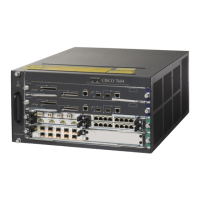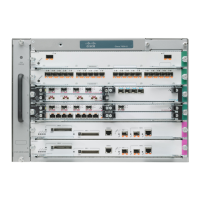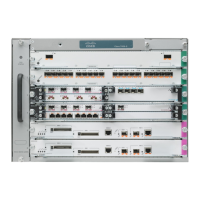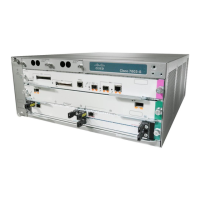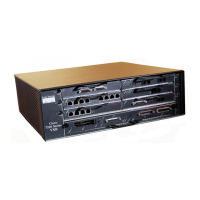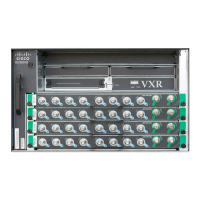32-20
Cisco 7600 Series Router Cisco IOS Software Configuration Guide—12.1E
78-14064-04
Chapter 32 Configuring PFC QoS
Understanding How PFC QoS Works
Note Aggregate policing works independently on each DFC-equipped switching module and
independently on the PFC2, which supports any non-DFC-equipped switching modules.
Aggregate policing does not combine flow statistics from different DFC-equipped switching
modules. You can display aggregate policing statistics for each DFC-equipped switching
module and for the PFC2 and any non-DFC-equipped switching modules supported by the
PFC2.
• PFC QoS applies the bandwidth limit specified in a microflow policer separately to each flow in
matched traffic as follows:
–
You can create microflow policers with up to 63 different rate and burst parameter
combinations.
–
You create microflow policers in a policy map class with the police flow command.
–
For IPX microflow policing, PFC QoS considers IPX traffic with the same source network,
destination network, and destination node to be part of the same flow, including traffic with
different source nodes or source sockets.
–
For MAC-Layer microflow policing, PFC QoS considers MAC-Layer traffic with the same
protocol and the same source and destination MAC-Layer addresses to be part of the same flow,
including traffic with different ethertypes.
–
By default, microflow policers only affect traffic routed by the MSFC. To enable microflow
policing of other traffic, including traffic in bridge groups, enter the mls qos bridged command
(see the “Enabling Microflow Policing of Bridged Traffic” section on page 32-50).
You can include both an aggregate policer and a microflow policer in each policy map class to police a
flow based on both its own bandwidth utilization and on its bandwidth utilization combined with that of
other flows.
Note If traffic is both aggregate and microflow policed, then the aggregate and microflow policers must both
be in the same policy-map class and each must use the same conform-action keyword option: drop,
set-dscp-transmit, set-prec-transmit, or transmit.
For example, you could create a microflow policer with a bandwidth limit suitable for individuals in a
group and you could create a named aggregate policer with bandwidth limits suitable for the group as a
whole. You could include both policers in policy map classes that match the group’s traffic. The
combination would affect individual flows separately and the group aggregately.
For policy map classes that include both an aggregate and a microflow policer, PFC QoS responds to an
out-of-profile status from either policer and, as specified by the policer, applies a new DSCP value or
drops the packet. If both policers return an out-of-profile status, then if either policer specifies that the
packet is to be dropped, it is dropped; otherwise PFC QoS applies a marked-down DSCP value.
Note To avoid inconsistent results, ensure that all traffic policed by the same aggregate policer has the same
trust state.

